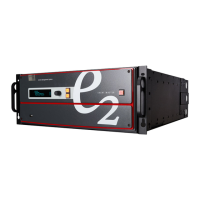3. General
3.3 Terms and definitions
3G
A 3 Gbit/s se rial digital 10-bit or 12-bit video interface (S MP TE 424 M and 425M).
Background (BCK)
Typically an unscaled source originating from a computer’s multi-head graphics card, or a fram e gr ab from a scaled source. E 2
provides tw o background s ources (BG A and BG B), each of which appears at the system’s lowest priority — visually in back or
underneath all other sour ces.
Chroma Key
A type of key where the hole-cutting information is derived from a color rather than from a v ideo level. A
n common ex ample on
television, is when the weatherman appears to be standing in front of a map. The map itself is a video signal, and the weatherm an
is in fact standing in front of a green (or blue) screen. On the switcher, the Chrom a Key process electronically s ubtracts the c olor
from the foreground image, and replaces it with video from the background image to form a com posi
te image.
Clip, Gain, Opacity
In sw itcher terminology, the process of fine-tuning a key of any type (luminance, linear, or chroma). Clipping sets the threshold for
the hole cutting circuitry, while "gain" defines the range an d sensitivity of adjustme nt. T he "opacity" is the transparency or density of
the key, as revealed over a background.
Computer Video
A generic term indicating v ideo that originates from a computer p latform. A progressive scan signal that follows VE SA (Video Elec-
tronics Standards A ssociation) standards, with typical r esolutions of 800 x 600, 1024 x 768 , 1280 x 1024, etc.
Crosspoint
The video switch (or button) that selects the input required on a particular s witcher bus.
Cut
Cut is an instantaneous switch from one video s ource to another.
DA (Dis tribution Amplifier)
A video device that inputs one video signal, and outputs multiple “identical” signals.
Destination (DST)
Destination is a location to which you can route the output of an E2. A destination can be con figur ed as:
• A s ingle screen (one projector)
• Multiple screens (such as a wide screen application)
• An external processor (such as a ImagePRO -II)
DSK (Downstream Keyer)
A DS K is a key that is electronically located after all other switcher functions — visually on top of all other layers and buses.
Fader
See T-Bar.
GUI (Graphical User Interface)
A term that describes a status display based on graphics a
nd icons, rather than s trictly on numbers and letters.
HD-SDI (High Definition Serial Digital Interfa
ce)
HD-SDI signal is a high definition SDI signal (SM PTE 292M). Example formats are 720p, 1080i, and 1080p.
Key
An electronic (and visual) pr ocess whereby one image is electronically s uperimposed over another source or background. Keys are
typically us ed for titles, logos, and banners.
Keyframe
In a PIP “move,” a keyframe is a point where a n action or chang e occurs. For example, when a PIP moves from the upper right
corner to full screen, keyframe 1 is the upper right pos ition, and keyframe 2 is the full s creen position of the P IP.
18
R5905948 E2 12/12/2014

